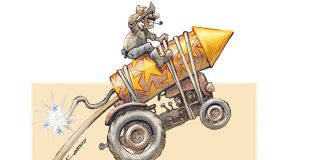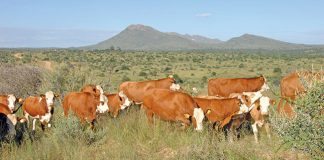
Photo: Bill Kerr
Cucurbits are important crops for modern humans. In all, there are about 1 000 species, but only 10 are cultivated worldwide and 23 more are grown regionally.
Well-known cucurbits are pumpkins, mainly Cucurbita maxima, and Halloween pumpkins (C. pepo), which include varieties such as gem squash and baby marrows (zucchini).
These two cross-pollinate, which can lead to some confusion. Every now and then, there is a news article accompanied by a photograph of a giant ‘gem squash’. This is usually a cross between a gem squash and a marrow.
Important cucurbit species grown in South Africa are butternut (C. moschata), cucumbers and melons.
Cucurbits were domesticated about 11 000 years ago, but today’s crops are vastly different to the wild species. One notable exception are the wild melons found in south-west South Africa and which are used for preserves.
Most of the wild species are considerably smaller and have a bitter taste; this keeps wild animals at bay and helps prevent their extinction. All parts of the plant are bitter. Today, 70 years later, I can recall my mother slicing cucumbers and then rubbing the slices together to extract the bitter froth that came out. Bitter gourds, popular in parts of Asia, still retain this bitterness.
Selections
C. pepo originated in Mexico and C. maxima in Argentina, but the origin of C. moschata is unknown.
Cucumbers came from India and East Asia, melons from India and Asia, and watermelons from Sudan (it is thought). As soon as our forebears recognised the potential of a wild species, they started to make selections and improvements from year to year.
They looked for fruit with less bitterness, and selected for both size and eating quality. This has continued to this day at a more rapid rate than ever; I’ve seen huge changes in my own lifetime.
The primitive cucumbers were only a few centimetres long; now there are 40cm-long Dutch types, while certain varieties can reach nearly 1m in length!
Most species of Cucurbitaceae will not readily cross with one another. In South Africa, the dominant pumpkin was the Boer pumpkin, a large, flattish, white cucurbit.
Good taste
When working for a seed company many years ago, I was given a sample of a slightly smaller grey hybrid pumpkin. The flesh colour and taste were superb. I presented it to my colleagues for comment, but their reaction was negative: the hybrid was simply too different to the market leaders at the time.
I was given permission, nonetheless, to try and sell it. So I took a number of the pumpkins to market, handed them to the agents for comment and I told them it was a hybrid. They asked what a hybrid was and I explained. One agent asked whether it was like crossing a donkey with a horse to get a mule. I said it was something like that!
The new variety took off and grey pumpkins are now common.
A couple of years after their introduction, while visiting a market, I was amused to hear the salespeople referring to them as donkey pumpkins!
Bill Kerr is a vegetable specialist and breeder.










